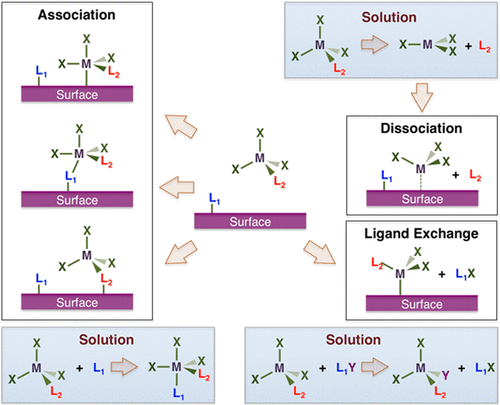当前位置:
X-MOL 学术
›
Acc. Chem. Res.
›
论文详情
Our official English website, www.x-mol.net, welcomes your
feedback! (Note: you will need to create a separate account there.)
The Chemistry of Inorganic Precursors during the Chemical Deposition of Films on Solid Surfaces
Accounts of Chemical Research ( IF 16.4 ) Pub Date : 2018-02-28 00:00:00 , DOI: 10.1021/acs.accounts.8b00012 Seán T. Barry 1 , Andrew V. Teplyakov 2 , Francisco Zaera 3
Accounts of Chemical Research ( IF 16.4 ) Pub Date : 2018-02-28 00:00:00 , DOI: 10.1021/acs.accounts.8b00012 Seán T. Barry 1 , Andrew V. Teplyakov 2 , Francisco Zaera 3
Affiliation

|
The deposition of thin solid films is central to many industrial applications, and chemical vapor deposition (CVD) methods are particularly useful for this task. For one, the isotropic nature of the adsorption of chemical species affords even coverages on surfaces with rough topographies, an increasingly common requirement in microelectronics. Furthermore, by splitting the overall film-depositing reactions into two or more complementary and self-limiting steps, as it is done in atomic layer depositions (ALD), film thicknesses can be controlled down to the sub-monolayer level. Thanks to the availability of a vast array of inorganic and metalorganic precursors, CVD and ALD are quite versatile and can be engineered to deposit virtually any type of solid material. On the negative side, the surface chemistry that takes place in these processes is often complex, and can include undesirable side reactions leading to the incorporation of impurities in the growing films. Appropriate precursors and deposition conditions need to be chosen to minimize these problems, and that requires a proper understanding of the underlying surface chemistry. The precursors for CVD and ALD are often designed and chosen based on their known thermal chemistry from inorganic chemistry studies, taking advantage of the vast knowledge developed in that field over the years. Although a good first approximation, however, this approach can lead to wrong choices, because the reactions of these precursors at gas–solid interfaces can be quite different from what is seen in solution. For one, solvents often aid in the displacement of ligands in metalorganic compounds, providing the right dielectric environment, temporarily coordinating to the metal, or facilitating multiple ligand–complex interactions to increase reaction probabilities; these options are not available in the gas–solid reactions associated with CVD and ALD. Moreover, solid surfaces act as unique “ligands”, if these reactions are to be viewed from the point of view of the metalorganic complexes used as precursors: they are bulky and rigid, can provide multiple binding sites for a single reaction, and can promote unique bonding modes, especially on metals, which have delocalized electronic structures. The differences between the molecular and surface chemistry of CVD and ALD precursors can result in significant variations in their reactivity, ultimately leading to unpredictable properties in the newly grown films. In this Account, we discuss some of the main similarities and differences in chemistry that CVD/ALD precursors follow on surfaces when contrasted against their known behavior in solution, with emphasis on our own work but also referencing other key contributions. Our approach is unique in that it combines expertise from the inorganic, surface science, and quantum-mechanics fields to better understand the mechanistic details of the chemistry of CVD and ALD processes and to identify new criteria to consider when designing CVD/ALD precursors.
中文翻译:

固体表面上的薄膜化学沉积过程中的无机前体化学
固体薄膜的沉积对于许多工业应用而言都是至关重要的,化学气相沉积(CVD)方法对于此任务特别有用。首先,化学物质吸附的各向同性性质使表面形貌粗糙的表面均匀覆盖,这是微电子学中越来越普遍的要求。此外,通过将整个薄膜沉积反应分为两个或多个互补的自限步骤,就像在原子层沉积(ALD)中所做的那样,可以将薄膜厚度控制在亚单层以下。由于有大量的无机和金属有机前驱物可供使用,因此CVD和ALD非常通用,可以设计成可沉积几乎任何类型的固体材料。在消极的一面,在这些过程中发生的表面化学反应通常很复杂,并且可能包括不希望的副反应,从而导致在生长的薄膜中掺入杂质。需要选择适当的前驱物和沉积条件以最大程度地减少这些问题,并且这需要对底层的表面化学性质有适当的了解。CVD和ALD的前体通常是根据无机化学研究中已知的热化学来设计和选择的,这要利用多年来在该领域积累的丰富知识。尽管这是一个很好的第一近似值,但是这种方法可能会导致错误的选择,因为这些前体在气固界面的反应可能与溶液中的反应完全不同。一方面 溶剂通常有助于取代金属有机化合物中的配体,提供合适的介电环境,暂时与金属配位,或促进多种配体-络合物的相互作用,以提高反应概率;这些选项在与CVD和ALD相关的气固反应中不可用。此外,如果要从用作前体的金属有机配合物的角度来看这些反应,则固体表面将充当唯一的“配体”:它们庞大且刚性,可以为单个反应提供多个结合位点,并可以促进独特的键合模式,尤其是在具有离域电子结构的金属上。CVD和ALD前体的分子化学和表面化学之间的差异可能会导致其反应性发生重大变化,最终导致新生长的薄膜具有不可预测的性能。在本报告中,我们讨论了CVD / ALD前驱体与表面在溶液中的已知行为形成对比时在化学上的一些主要异同,重点是我们自己的工作,但同时也提到了其他重要贡献。我们的方法之所以独特,是因为它将无机,表面科学和量子力学领域的专业知识相结合,可以更好地理解CVD和ALD工艺的化学机理细节,并确定设计CVD / ALD前体时要考虑的新标准。在强调我们自己的工作的同时,还要参考其他重要的贡献。我们的方法之所以独特,是因为它将无机,表面科学和量子力学领域的专业知识相结合,可以更好地理解CVD和ALD工艺的化学机理细节,并确定设计CVD / ALD前体时要考虑的新标准。在强调我们自己的工作的同时,还要参考其他重要的贡献。我们的方法之所以独特,是因为它将无机,表面科学和量子力学领域的专业知识相结合,可以更好地理解CVD和ALD工艺的化学机理细节,并确定设计CVD / ALD前体时要考虑的新标准。
更新日期:2018-02-28
中文翻译:

固体表面上的薄膜化学沉积过程中的无机前体化学
固体薄膜的沉积对于许多工业应用而言都是至关重要的,化学气相沉积(CVD)方法对于此任务特别有用。首先,化学物质吸附的各向同性性质使表面形貌粗糙的表面均匀覆盖,这是微电子学中越来越普遍的要求。此外,通过将整个薄膜沉积反应分为两个或多个互补的自限步骤,就像在原子层沉积(ALD)中所做的那样,可以将薄膜厚度控制在亚单层以下。由于有大量的无机和金属有机前驱物可供使用,因此CVD和ALD非常通用,可以设计成可沉积几乎任何类型的固体材料。在消极的一面,在这些过程中发生的表面化学反应通常很复杂,并且可能包括不希望的副反应,从而导致在生长的薄膜中掺入杂质。需要选择适当的前驱物和沉积条件以最大程度地减少这些问题,并且这需要对底层的表面化学性质有适当的了解。CVD和ALD的前体通常是根据无机化学研究中已知的热化学来设计和选择的,这要利用多年来在该领域积累的丰富知识。尽管这是一个很好的第一近似值,但是这种方法可能会导致错误的选择,因为这些前体在气固界面的反应可能与溶液中的反应完全不同。一方面 溶剂通常有助于取代金属有机化合物中的配体,提供合适的介电环境,暂时与金属配位,或促进多种配体-络合物的相互作用,以提高反应概率;这些选项在与CVD和ALD相关的气固反应中不可用。此外,如果要从用作前体的金属有机配合物的角度来看这些反应,则固体表面将充当唯一的“配体”:它们庞大且刚性,可以为单个反应提供多个结合位点,并可以促进独特的键合模式,尤其是在具有离域电子结构的金属上。CVD和ALD前体的分子化学和表面化学之间的差异可能会导致其反应性发生重大变化,最终导致新生长的薄膜具有不可预测的性能。在本报告中,我们讨论了CVD / ALD前驱体与表面在溶液中的已知行为形成对比时在化学上的一些主要异同,重点是我们自己的工作,但同时也提到了其他重要贡献。我们的方法之所以独特,是因为它将无机,表面科学和量子力学领域的专业知识相结合,可以更好地理解CVD和ALD工艺的化学机理细节,并确定设计CVD / ALD前体时要考虑的新标准。在强调我们自己的工作的同时,还要参考其他重要的贡献。我们的方法之所以独特,是因为它将无机,表面科学和量子力学领域的专业知识相结合,可以更好地理解CVD和ALD工艺的化学机理细节,并确定设计CVD / ALD前体时要考虑的新标准。在强调我们自己的工作的同时,还要参考其他重要的贡献。我们的方法之所以独特,是因为它将无机,表面科学和量子力学领域的专业知识相结合,可以更好地理解CVD和ALD工艺的化学机理细节,并确定设计CVD / ALD前体时要考虑的新标准。









































 京公网安备 11010802027423号
京公网安备 11010802027423号